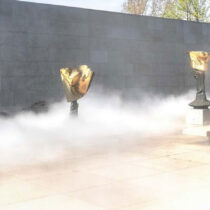In the framework if the research project carried out in Messenia, the oil producing region of Greece par excellence, relevant machinery and installations have been located, the older ones dating from the mid-nineteenth century. These types of machinery have been identified: In the first type, the crushing device consists of a lower and an upper stone and the press displays a stone base and a wooden superstructure. In the second, the crushing device is enlarged and the press is made exclusively of metal. In the third type, that signals that industrialization of energy, the central system is hydraulic, the crushing device becomes even more bulky and elevated and the press is furnished with a piston. In this later phase of the oil mill evolution more modern and developed types of press are used. The last hydraulic press stopped to be used around 1980, while the oil mills operating to day are equipped with centrifugal apparatuses. Not only the machinery, but also the type of the oil mill buildings is also diversified forming three groups: a. The small, single-spaced oil mills that are located in the olive production areas, process a small amount of olives and serve the needs of a few families. b. The enlarged oil-mills that have the capacity to accommodate large quantities of olives and are located in populated areas. c. The oil mill complexes that can handle an immense olive production and reflect the industrialization of energy and the increase of product.
Old Oil Mills of Messenia
29 Aug 2012
by Archaeology Newsroom
- A
- A
- A


